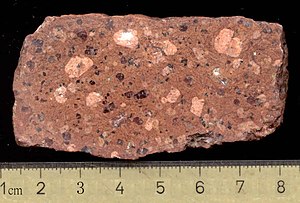Porphyry structure

Porphyry structure is a term used to describe the structure of igneous rock . It is named after the type-defining rocks, the porphyries . The porphyric structure is characterized by substantial differences in size of the mineral grains in the rock ( bimodal particle size distribution ). Therefore, in a porphyry rock, a distinction is made between ground mass (very small grains) and Einsprenglinge (larger grains). The proportion of the base mass to the sprinkles is variable.
The similar-looking structure of some metamorphic rocks is not referred to as porphyry, but as porphyroblastic , due to the different method of formation.
If one wants to emphasize that igneous rock has no insets, that is, in fact only consists of basic material, one speaks of an aphyric structure .
Properties and origin
The basic mass or matrix of the rock is either glassy or very fine-grained, so that it can sometimes even be broken down into individual mineral grains under the microscope, but at least under a magnifying glass.
The Einsprenglinge have a multiple of the grain size of the base material and are clearly visible under a magnifying glass or even with the naked eye. To a certain extent, they swim in the homogeneous matrix. Sprinkling crystals are usually idiomorphic . Often there are only crystals of a few - one to three - of the minerals contained in the entire rock. In basalts , such insects usually consist only of plagioclase , olivine and pyroxene , in rhyolites mostly only of alkali feldspar and quartz .
Porphyry structures occur mainly in volcanic rocks that are solidified directly on the earth's surface as a lava flow or only at a shallow depth as sub- volcanite. The bimodal grain size distribution is the result of a two-stage crystallization process:
- First, the molten rock cools down very slowly in a magma chamber deep underground. The first crystals form as soon as the melting temperature of the relevant minerals is undershot (see → fractional crystallization ). These crystals grow very slowly and undisturbed in the melt.
- A volcanic eruption pushes the melt together with the crystals that have already formed in it from the magma chamber to the earth's surface. The melt cools down very quickly or is even quenched . It therefore solidifies in an amorphous manner or crystallizes only very finely.
This rapidly cooled melt forms the basic mass of the rock. The large crystals, which previously grew slowly in the magma chamber, are enclosed in it as traps . Occasionally, plutonites also have a porphyry structure if, due to a change in temperature or pressure, some mineral phases of the magma have crystallized out more quickly than the others. In this case, the base mass is fine to medium-grained and the sprinkles can reach several centimeters in size.
In some rocks, for example with the andesites , dolerites or lamprophyren , there are transitional forms that approximate the ophitic structure.
Examples of porphyry structure
Microsyenogranite Beucha
literature
- Wolfhard Wimmenauer: Petrography of igneous and metamorphic rocks . Enke, Stuttgart 1985, ISBN 3-432-94671-6


